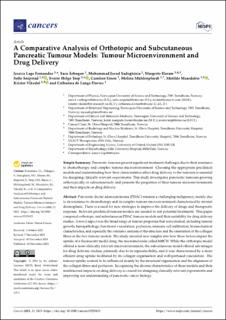| dc.contributor.author | Lage Fernandez, Jessica | |
| dc.contributor.author | Årbogen, Sara Beate Stjern | |
| dc.contributor.author | Sadeghinia, Mohammadjavad | |
| dc.contributor.author | Haram, Karin Margrete | |
| dc.contributor.author | Snipstad, Sofie | |
| dc.contributor.author | Torp, Sverre Helge | |
| dc.contributor.author | Einen, Caroline | |
| dc.contributor.author | Mühlenpfordt, Melina | |
| dc.contributor.author | Maardalen, Matilde | |
| dc.contributor.author | Vikedal, Krister | |
| dc.contributor.author | Davies, Catharina de Lange | |
| dc.date.accessioned | 2024-01-12T08:19:25Z | |
| dc.date.available | 2024-01-12T08:19:25Z | |
| dc.date.created | 2023-11-21T15:44:13Z | |
| dc.date.issued | 2023 | |
| dc.identifier.citation | Cancers. 2023, 15 (22), 5415-5415. | en_US |
| dc.identifier.issn | 2072-6694 | |
| dc.identifier.uri | https://hdl.handle.net/11250/3111237 | |
| dc.description.abstract | Pancreatic ductal adenocarcinoma (PDAC) remains a challenging malignancy, mainly due to its resistance to chemotherapy and its complex tumour microenvironment characterised by stromal desmoplasia. There is a need for new strategies to improve the delivery of drugs and therapeutic response. Relevant preclinical tumour models are needed to test potential treatments. This paper compared orthotopic and subcutaneous PDAC tumour models and their suitability for drug delivery studies. A novel aspect was the broad range of tumour properties that were studied, including tumour growth, histopathology, functional vasculature, perfusion, immune cell infiltration, biomechanical characteristics, and especially the extensive analysis of the structure and the orientation of the collagen fibres in the two tumour models. The study unveiled new insights into how these factors impact the uptake of a fluorescent model drug, the macromolecule called 800CW. While the orthotopic model offered a more clinically relevant microenvironment, the subcutaneous model offered advantages for drug delivery studies, primarily due to its reproducibility, and it was characterised by a more efficient drug uptake facilitated by its collagen organisation and well-perfused vasculature. The tumour uptake seemed to be influenced mainly by the structural organisation and the alignment of the collagen fibres and perfusion. Recognising the diverse characteristics of these models and their multifaceted impacts on drug delivery is crucial for designing clinically relevant experiments and improving our understanding of pancreatic cancer biology. | en_US |
| dc.language.iso | eng | en_US |
| dc.publisher | MDPI | en_US |
| dc.rights | Navngivelse 4.0 Internasjonal | * |
| dc.rights.uri | http://creativecommons.org/licenses/by/4.0/deed.no | * |
| dc.title | A Comparative Analysis of Orthotopic and Subcutaneous Pancreatic Tumour Models: Tumour Microenvironment and Drug Delivery | en_US |
| dc.title.alternative | A Comparative Analysis of Orthotopic and Subcutaneous Pancreatic Tumour Models: Tumour Microenvironment and Drug Delivery | en_US |
| dc.type | Peer reviewed | en_US |
| dc.type | Journal article | en_US |
| dc.description.version | publishedVersion | en_US |
| dc.source.pagenumber | 5415-5415 | en_US |
| dc.source.volume | 15 | en_US |
| dc.source.journal | Cancers | en_US |
| dc.source.issue | 22 | en_US |
| dc.identifier.doi | 10.3390/cancers15225415 | |
| dc.identifier.cristin | 2199833 | |
| cristin.ispublished | true | |
| cristin.fulltext | original | |
| cristin.qualitycode | 1 | |

